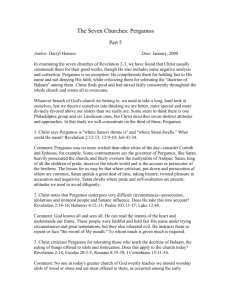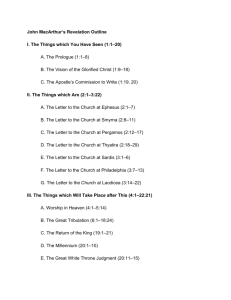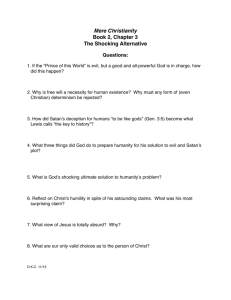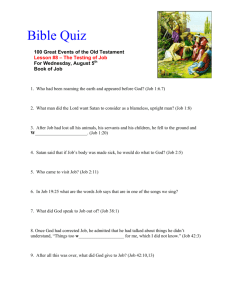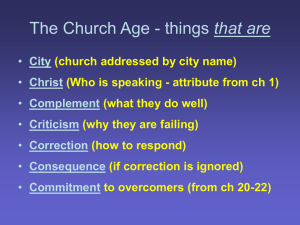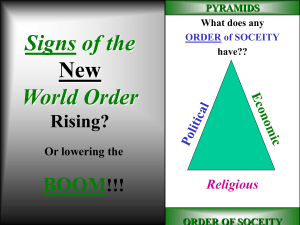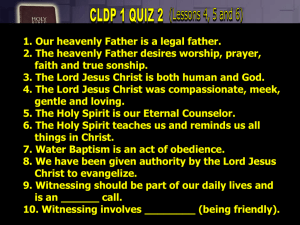File
advertisement
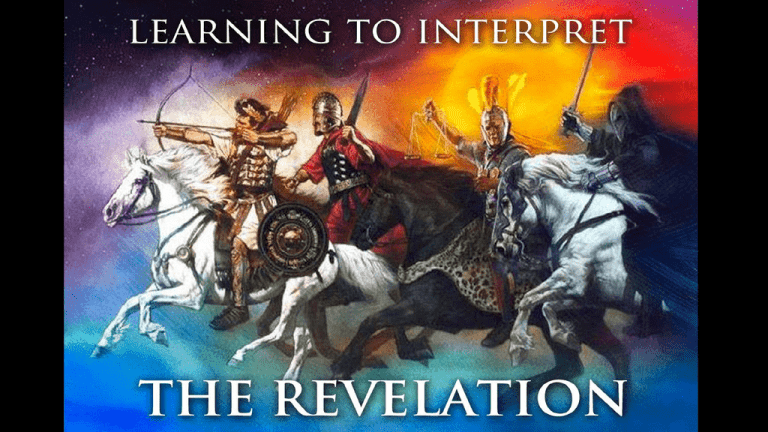
• We come to the letter the Risen Christ sent to the church at Pergamos, sometimes translated Pergamum. This city was north of Ephesus and Smyrna. It was not the financial and trade center as were its southern cousins, but it was a capital city, first of the ancient Attalid Empire and then of the Roman Province of Asia. At the time of the message of the risen Christ to the church at Pergamos, the city had been a regional capital for three centuries. It was by far the most famous city of Asia. • We come to the letter the Risen Christ sent to the church at Pergamos, sometimes translated Pergamum. This city was north of Ephesus and Smyrna. It was not the financial and trade center as were its southern cousins, but it was a capital city, first of the ancient Attalid Empire and then of the Roman Province of Asia. At the time of the message of the risen Christ to the church at Pergamos, the city had been a regional capital for three centuries. It was by far the most famous city of Asia. • We come to the letter the Risen Christ sent to the church at Pergamos, sometimes translated Pergamum. This city was north of Ephesus and Smyrna. It was not the financial and trade center as were its southern cousins, but it was a capital city, first of the ancient Attalid Empire and then of the Roman Province of Asia. At the time of the message of the risen Christ to the church at Pergamos, the city had been a regional capital for three centuries. It was by far the most famous city of Asia. The Church at Pergamos Revelation 2:12-17 12 “And to the angel of the church in Pergamos write, ‘These things says He who has the sharp two-edged sword: 13 “I know your works, and where you dwell, where Satan’s throne is. And you hold fast to My name, and did not deny My faith even in the days in which Antipas was My faithful martyr, who was killed among you, where Satan dwells. 14 But I have a few things against you, because you have there those who hold the doctrine of Balaam, who taught Balak to put a stumbling block before the children of Israel, to eat things sacrificed to idols, and to commit sexual immorality. 15 Thus you also have those who hold the doctrine of the Nicolaitans, which thing I hate. 16 Repent, or else I will come to you quickly and will fight against them with the sword of My mouth. 17 “He who has an ear, let him hear what the Spirit says to the churches. To him who overcomes I will give some of the hidden manna to eat. And I will give him a white stone, and on the stone a new name written which no one knows except him who receives it.” • Wow, is this going to be fun! The Lord uses such picturesque language in His message to the believers in Pergamos, but we know that in each word picture is an important message – to them and to us. We will use our tools to decipher what is meant by • Wow, is this going to be fun! The Lord uses such picturesque language in His message to the believers in Pergamos, but we know that in each word picture is an important message – to them and to us. We will use our tools to decipher what is meant by • Where Satan´s throne is and where Satan dwells • The doctrine of Balaam • The stumbling block of Balak • The doctrine of the Nicolaitans • Hidden manna • White stone with a new name • 2:12 “And to the angel of the church in Pergamos write, ‘These things says He who has the sharp two-edged sword: - We have already done all the work necessary to understand this verse. Angel means messenger, and in this case, is probably the pastor of the church. John saw the Risen Christ as he worshipped on the Isle of Patmos on the Lord´s Day, and Jesus had a sharp two-edged sword coming out of His mouth (1:16). • 2:12 “And to the angel of the church in Pergamos write, ‘These things says He who has the sharp two-edged sword: - We have already done all the work necessary to understand this verse. Angel means messenger, and in this case, is probably the pastor of the church. John saw the Risen Christ as he worshipped on the Isle of Patmos on the Lord´s Day, and Jesus had a sharp two-edged sword coming out of His mouth (1:16). • 2:12 “And to the angel of the church in Pergamos write, ‘These things says He who has the sharp two-edged sword: - We have already done all the work necessary to understand this verse. Angel means messenger, and in this case, is probably the pastor of the church. John saw the Risen Christ as he worshipped on the Isle of Patmos on the Lord´s Day, and Jesus had a sharp two-edged sword coming out of His mouth (1:16). • Letting Scripture explain Scripture, we examined other passages that referenced sharp swords and two-edged swords. Although in some of those passages “swords” meant just plain ole swords, in a number of passages “swords” referred to words. And we saw that specifically the sharp two-edged sword signified the Word of God as in • Letting Scripture explain Scripture, we examined other passages that referenced sharp swords and two-edged swords. Although in some of those passages “swords” meant just plain ole swords, in a number of passages “swords” referred to words. And we saw that specifically the sharp two-edged sword signified the Word of God as in • Letting Scripture explain Scripture, we examined other passages that referenced sharp swords and two-edged swords. Although in some of those passages “swords” meant just plain ole swords, in a number of passages “swords” referred to words. And we saw that specifically the sharp two-edged sword signified the Word of God as in Hebrews 4:12 For the word of God is living and powerful, and sharper than any two-edged sword, piercing even to the division of soul and spirit, and of joints and marrow, and is a discerner of the thoughts and intents of the heart. • If we examine the history of Pergamos, we discover a fact that helps us to further understand why Christ would select this particular description of Himself to use in His letter to Pergamos. Pergamos was known for its library which contained over 200,000 volumes, every one of them hand written. In fact, we get the name parchment, which is a paper made from animal skins from the Greek name Pergamene Charta, which means Pergamene sheet. • If we examine the history of Pergamos, we discover a fact that helps us to further understand why Christ would select this particular description of Himself to use in His letter to Pergamos. Pergamos was known for its library which contained over 200,000 volumes, every one of them hand written. In fact, we get the name parchment, which is a paper made from animal skins from the Greek name Pergamene Charta, which means Pergamene sheet. • If we examine the history of Pergamos, we discover a fact that helps us to further understand why Christ would select this particular description of Himself to use in His letter to Pergamos. Pergamos was known for its library which contained over 200,000 volumes, every one of them hand written. In fact, we get the name parchment, which is a paper made from animal skins from the Greek name Pergamene Charta, which means Pergamene sheet. • The risen Lord is reminding His people, amid the multitude of books you have at your disposal in your own city, remember that My Book, My Word, which is sharper than any two-edged sword, is the one that really matters. This is a fit reminder for us in the day when the written word by way of printed books, electronic books, web sites, and blogs has caused both the wisdom and the foolishness of man to be published abroad. We must remember there is only one Word which will last forever! • 13 “I know your works, and where you dwell, where Satan’s throne is. And you hold fast to My name, and did not deny My faith even in the days in which Antipas was My faithful martyr, who was killed among you, where Satan dwells. – To understand this verse, we must answer three questions: • Who is Satan? • Who is Antipas and where did he dwell? • What is meant by Satan´s throne? • The name Satan appears first in the Bible in 1 Chr. 21:1. But all the books of the Bible were not inserted into the canon chronologically. For instance, the events of the Book of Job predate all of the events of Exodus and all of the books which follow it. Job and his family almost certainly lived even before Noah. It is very likely that Job was the first book of Holy Scripture to be breathed out to men by the Spirit of God. • The name Satan appears first in the Bible in 1 Chr. 21:1. But all the books of the Bible were not inserted into the canon chronologically. For instance, the events of the Book of Job predate all of the events of Exodus and all of the books which follow it. Job and his family almost certainly lived even before Noah. It is very likely that Job was the first book of Holy Scripture to be breathed out to men by the Spirit of God. • The name Satan appears first in the Bible in 1 Chr. 21:1. But all the books of the Bible were not inserted into the canon chronologically. For instance, the events of the Book of Job predate all of the events of Exodus and all of the books which follow it. Job and his family almost certainly lived even before Noah. It is very likely that Job was the first book of Holy Scripture to be breathed out to men by the Spirit of God. • All of this helps us understand why Job saw dinosaurs like Behemoth, a colossal beast like the Brachiosaurus. The dinosaurs, like all land animals, were destroyed in the flood, except for two of each kind of dinosaur preserved on the ark. Almost all of the dinosaurs that departed the ark, failed to repopulate the earth, because the conditions of the post-flood earth were so dramatically inferior to those of pre-flood days. They simply could not survive. • All of this helps us understand why Job saw dinosaurs like Behemoth, a colossal beast like the Brachiosaurus. The dinosaurs, like all land animals, were destroyed in the flood, except for two of each kind of dinosaur preserved on the ark. Almost all of the dinosaurs that departed the ark, failed to repopulate the earth, because the conditions of the post-flood earth were so dramatically inferior to those of pre-flood days. They simply could not survive. • All of this helps us understand why Job saw dinosaurs like Behemoth, a colossal beast like the Brachiosaurus. The dinosaurs, like all land animals, were destroyed in the flood, except for two of each kind of dinosaur preserved on the ark. Almost all of the dinosaurs that departed the ark, failed to repopulate the earth, because the conditions of the post-flood earth were so dramatically inferior to those of pre-flood days. They simply could not survive. • All of these interesting tidbits are here to say that the Book of Job is from a very early time in the history of the earth and in the beginning of the book it says, • Job 1:6 Now there was a day when the sons of God came to present themselves before the LORD, and Satan also came among them. • All of these interesting tidbits are here to say that the Book of Job is from a very early time in the history of the earth and in the beginning of the book it says, • Job 1:6 Now there was a day when the sons of God came to present themselves before the LORD, and Satan also came among them. • Although Satan is clearly used as a proper name, it does have a meaning – adversary. In this first introduction of him in the Book of Job, Satan is clearly the adversary, the enemy, of man as well as God. • Although Satan is clearly used as a proper name, it does have a meaning – adversary. In this first introduction of him in the Book of Job, Satan is clearly the adversary, the enemy, of man as well as God. • Time will not allow us to follow the entire chain through Scripture to trace the history of Satan from beginning to end. However, Ez. 28:12-19 and Is. 14:12-15 show us that Satan was created as a holy angel named Lucifer. He desired to “exalt his throne” and “be like the most High.” For his blasphemous rebellion he was cast down to the earth and destined to be confined in the “lowest depths of the Pit.” • Time will not allow us to follow the entire chain through Scripture to trace the history of Satan from beginning to end. However, Ez. 28:12-19 and Is. 14:12-15 show us that Satan was created as a holy angel named Lucifer. He desired to “exalt his throne” and “be like the most High.” For his blasphemous rebellion he was cast down to the earth and destined to be confined in the “lowest depths of the Pit.” • Satan is best and most completely identified later in Revelation itself in • Revelation 12:9 So the great dragon was cast out, that serpent of old, called the Devil and Satan, who deceives the whole world; he was cast to the earth, and his angels were cast out with him. Therefore, we see • Satan is the devil, a fallen angel, an antagonist of God and man who desires to divert the worship of God to himself. • The throne of Satan is also a reference to a place of idolatry and false worship. • History reveals that Antipas was the pastor of the church at Pergamos who was roasted in a copper bull because he refused to worship Caesar instead of Christ. Therefore, we see • Satan is the devil, a fallen angel, an antagonist of God and man who desires to divert the worship of God to himself. • The throne of Satan is also a reference to a place of idolatry and false worship. • History reveals that Antipas was the pastor of the church at Pergamos who was roasted in a copper bull because he refused to worship Caesar instead of Christ. Therefore, we see • Satan is the devil, a fallen angel, an antagonist of God and man who desires to divert the worship of God to himself. • The throne of Satan is also a reference to a place of idolatry and false worship. • History reveals that Antipas was the pastor of the church at Pergamos who was roasted in a copper bull because he refused to worship Caesar instead of Christ. Therefore, we see • Satan is the devil, a fallen angel, an antagonist of God and man who desires to divert the worship of God to himself. • The throne of Satan is also a reference to a place of idolatry and false worship. • History reveals that Antipas was the pastor of the church at Pergamos who was roasted in a copper bull because he refused to worship Caesar instead of Christ. • Jesus says to the church at Pergamos, you live where Satan continues to entice people to worship other gods, but you have been faithful like Antipas, who was My witness even at the cost of his life. • Jesus says to the church at Pergamos, you live where Satan continues to entice people to worship other gods, but you have been faithful like Antipas, who was My witness even at the cost of his life. • 14 But I have a few things against you, because you have there those who hold the doctrine of Balaam, who taught Balak to put a stumbling block before the children of Israel, to eat things sacrificed to idols, and to commit sexual immorality. – Here our questions are only two: • Who was Balaam, and what was his doctrine? • What did he teach Balak that caused Balak to put a stumbling block before Israel? • When we enter these two names in a Bible search engine, we quickly discover they are entwined. The story is told in Num. 22-31. Balaam was a soothsayer who was afraid to blatantly disobey God by cursing Israel as Balak, king of Moab, had hired him to do. So Balaam counseled Balak to send the Moabite women to Israel´s camp to seduce the men. • When we enter these two names in a Bible search engine, we quickly discover they are entwined. The story is told in Num. 22-31. Balaam was a soothsayer who was afraid to blatantly disobey God by cursing Israel as Balak, king of Moab, had hired him to do. So Balaam counseled Balak to send the Moabite women to Israel´s camp to seduce the men. • When we enter these two names in a Bible search engine, we quickly discover they are entwined. The story is told in Num. 22-31. Balaam was a soothsayer who was afraid to blatantly disobey God by cursing Israel as Balak, king of Moab, had hired him to do. So Balaam counseled Balak to send the Moabite women to Israel´s camp to seduce the men. • Numbers 25:1–2 … the people began to commit harlotry with the women of Moab. 2 They invited the people to the sacrifices of their gods, and the people ate and bowed down to their gods. • Apparently in Pergamos, some were counseling compromise with the practices of those worshipping the abundant idols of the city like Asklepios, Zeus, and even Caesar. • Numbers 25:1–2 … the people began to commit harlotry with the women of Moab. 2 They invited the people to the sacrifices of their gods, and the people ate and bowed down to their gods. • Apparently in Pergamos, some were counseling compromise with the practices of those worshipping the abundant idols of the city like Asklepios, Zeus, and even Caesar. • 15 Thus you also have those who hold the doctrine of the Nicolaitans, which thing I hate. – In the letter to Ephesus we discovered that the name Nicolaitan is a compound word that means “to conquer the people.” These people who desired power more than Christ-like service, wanted to develop a separation between clergy and laity so that church leaders could rule over the people. While the Ephesians sternly resisted, the Pergamos church had allowed this philosophy to begin to take hold. • 15 Thus you also have those who hold the doctrine of the Nicolaitans, which thing I hate. – In the letter to Ephesus we discovered that the name Nicolaitan is a compound word that means “to conquer the people.” These people who desired power more than Christ-like service, wanted to develop a separation between clergy and laity so that church leaders could rule over the people. While the Ephesians sternly resisted, the Pergamos church had allowed this philosophy to begin to take hold. • 15 Thus you also have those who hold the doctrine of the Nicolaitans, which thing I hate. – In the letter to Ephesus we discovered that the name Nicolaitan is a compound word that means “to conquer the people.” These people who desired power more than Christ-like service, wanted to develop a separation between clergy and laity so that church leaders could rule over the people. While the Ephesians sternly resisted, the Pergamos church had allowed this philosophy to begin to take hold. • 15 Thus you also have those who hold the doctrine of the Nicolaitans, which thing I hate. – In the letter to Ephesus we discovered that the name Nicolaitan is a compound word that means “to conquer the people.” These people who desired power more than Christ-like service, wanted to develop a separation between clergy and laity so that church leaders could rule over the people. While the Ephesians sternly resisted, the Pergamos church had allowed this philosophy to begin to take hold. • 16 Repent, or else I will come to you quickly and will fight against them with the sword of My mouth. – Christ says, “Turn away from compromise and self-empowerment.” • 16 Repent, or else I will come to you quickly and will fight against them with the sword of My mouth. – Christ says, “Turn away from compromise and self-empowerment.” • 17 “He who has an ear, let him hear what the Spirit says to the churches. To him who overcomes I will give some of the hidden manna to eat. – Scripture explains Scripture. Manna was the bread from heaven given to Israel in the wilderness. Jesus said He was the bread from heaven. He is “hidden” from those who do not trust in Him, but He fills faithful believers. • 17 “He who has an ear, let him hear what the Spirit says to the churches. To him who overcomes I will give some of the hidden manna to eat. – Scripture explains Scripture. Manna was the bread from heaven given to Israel in the wilderness. Jesus said He was the bread from heaven. He is “hidden” from those who do not trust in Him, but He fills faithful believers. • 17 “He who has an ear, let him hear what the Spirit says to the churches. To him who overcomes I will give some of the hidden manna to eat. – Scripture explains Scripture. Manna was the bread from heaven given to Israel in the wilderness. Jesus said He was the bread from heaven. He is “hidden” from those who do not trust in Him, but He fills faithful believers. • 17 “He who has an ear, let him hear what the Spirit says to the churches. To him who overcomes I will give some of the hidden manna to eat. – Scripture explains Scripture. Manna was the bread from heaven given to Israel in the wilderness. Jesus said He was the bread from heaven. He is “hidden” from those who do not trust in Him, but He fills faithful believers. • And I will give him a white stone, and on the stone a new name written which no one knows except him who receives it.” – Nowhere else in Scripture do we read of a white stone. So, plain sense makes sense. In eternity, one of the gifts of the Lord to His obedient followers will be a white stone with a new name on it which no one knows. Jesus will return on a white horse with a name written on His thigh which no one knows except Himself. • And I will give him a white stone, and on the stone a new name written which no one knows except him who receives it.” – Nowhere else in Scripture do we read of a white stone. So, plain sense makes sense. In eternity, one of the gifts of the Lord to His obedient followers will be a white stone with a new name on it which no one knows. Jesus will return on a white horse with a name written on His thigh which no one knows except Himself. • And I will give him a white stone, and on the stone a new name written which no one knows except him who receives it.” – Nowhere else in Scripture do we read of a white stone. So, plain sense makes sense. In eternity, one of the gifts of the Lord to His obedient followers will be a white stone with a new name on it which no one knows. Jesus will return on a white horse with a name written on His thigh which no one knows except Himself. • What is the name? I don´t know! No one knows – now. We shall know – then! Today, Jesus is the “Petra” – the bedrock. Peter was the “Petros” – the little rock. Peter said we believers are “living stones,” being built into a spiritual house. We are made white – righteous. One day we will be given a white stone which commemorates all Christ has made us to be! • What is the name? I don´t know! No one knows – now. We shall know – then! Today, Jesus is the “Petra” – the bedrock. Peter was the “Petros” – the little rock. Peter said we believers are “living stones,” being built into a spiritual house. We are made white – righteous. One day we will be given a white stone which commemorates all Christ has made us to be! • What is the name? I don´t know! No one knows – now. We shall know – then! Today, Jesus is the “Petra” – the bedrock. Peter was the “Petros” – the little rock. Peter said we believers are “living stones,” being built into a spiritual house. We are made white – righteous. One day we will be given a white stone which commemorates all Christ has made us to be! • What is the name? I don´t know! No one knows – now. We shall know – then! Today, Jesus is the “Petra” – the bedrock. Peter was the “Petros” – the little rock. Peter said we believers are “living stones,” being built into a spiritual house. We are made white – righteous. One day we will be given a white stone which commemorates all Christ has made us to be! • What is the name? I don´t know! No one knows – now. We shall know – then! Today, Jesus is the “Petra” – the bedrock. Peter was the “Petros” – the little rock. Peter said we believers are “living stones,” being built into a spiritual house. We are made white – righteous. One day we will be given a white stone which commemorates all Christ has made us to be! • What is the name? I don´t know! No one knows – now. We shall know – then! Today, Jesus is the “Petra” – the bedrock. Peter was the “Petros” – the little rock. Peter said we believers are “living stones,” being built into a spiritual house. We are made white – righteous. One day we will be given a white stone which commemorates all Christ has made us to be! • What is the name? I don´t know! No one knows – now. We shall know – then! Today, Jesus is the “Petra” – the bedrock. Peter was the “Petros” – the little rock. Peter said we believers are “living stones,” being built into a spiritual house. We are made white – righteous. One day we will be given a white stone which commemorates all Christ has made us to be! The Applications • The application to the church of Pergamos in John´s day has been explained as we examined the text. The Applications • Historically, the Pergamos period was from A.D. 312 - 606. Constantine “christianized” the empire by a declaration from the throne. This led to two tragic processes: the marriage of church and state, with the state usually being the head. And accommodation and compromise between popular religions and Christianity. The Applications • Historically, the Pergamos period was from A.D. 312 - 606. Constantine “christianized” the empire by a declaration from the throne. This led to two tragic processes: the marriage of church and state, with the state usually being the head. And accommodation and compromise between popular religions and Christianity. The Applications • Historically, the Pergamos period was from A.D. 312 - 606. Constantine “christianized” the empire by a declaration from the throne. This led to two tragic processes: the marriage of church and state, with the state usually being the head. And accommodation and compromise between popular religions and Christianity. Thus developed basilicas, vestments for priests, thrones for bishops, altars decorated with gold and precious gems, and a mixing of pagan festivals with Christian celebrations. Remember that the Nicolaitans were those promoting a separation between laity and clergy. The Nicolaitans won. In 325 A.D. the Council of Nicea declared the supremacy of regional bishops over local pastors and church members. The ascendency of the papacy began. Thus developed basilicas, vestments for priests, thrones for bishops, altars decorated with gold and precious gems, and a mixing of pagan festivals with Christian celebrations. Remember that the Nicolaitans were those promoting a separation between laity and clergy. The Nicolaitans won. In 325 A.D. the Council of Nicea declared the supremacy of regional bishops over local pastors and church members. The ascendency of the papacy began. Thus developed basilicas, vestments for priests, thrones for bishops, altars decorated with gold and precious gems, and a mixing of pagan festivals with Christian celebrations. Remember that the Nicolaitans were those promoting a separation between laity and clergy. The Nicolaitans won. In 325 A.D. the Council of Nicea declared the supremacy of regional bishops over local pastors and church members. The ascendency of the papacy began. Thus developed basilicas, vestments for priests, thrones for bishops, altars decorated with gold and precious gems, and a mixing of pagan festivals with Christian celebrations. Remember that the Nicolaitans were those promoting a separation between laity and clergy. The Nicolaitans won. In 325 A.D. the Council of Nicea declared the supremacy of regional bishops over local pastors and church members. The ascendency of the papacy began. • How can we miss the application to the church today? Religious idolatry is everywhere. Compromise is pervasive. Standing for truth brings persecution. But Christ still indwells and empowers the true believer, and makes him a righteous living stone! • How can we miss the application to the church today? Religious idolatry is everywhere. Compromise is pervasive. Standing for truth brings persecution. But Christ still indwells and empowers the true believer, and makes him a righteous living stone! • How can we miss the application to the church today? Religious idolatry is everywhere. Compromise is pervasive. Standing for truth brings persecution. But Christ still indwells and empowers the true believer, and makes him a righteous living stone! • How can we miss the application to the church today? Religious idolatry is everywhere. Compromise is pervasive. Standing for truth brings persecution. But Christ still indwells and empowers the true believer, and makes him a righteous living stone!
